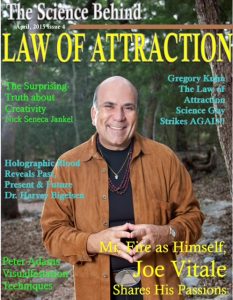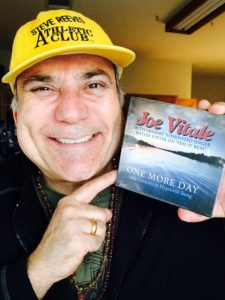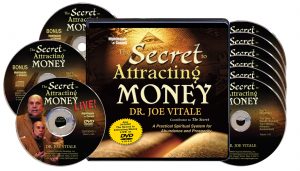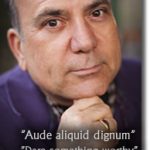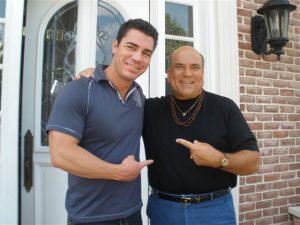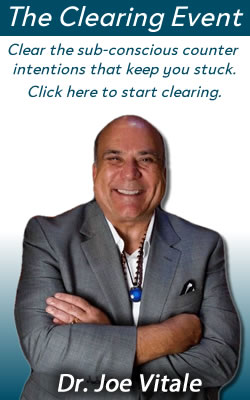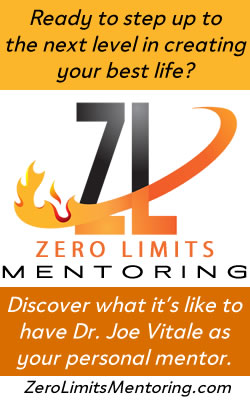Tag: the movie The Secret
Law of Attraction Songs
This exclusive article was first published in the April 2015 issue of The Science Behind Law of Attraction national magazine and in the April 2015 Austin All Natural Central Texas magazine. It’s mostly about the Law of Attraction songs on my latest singer-songwriter album, One More Day: Life Lessons in Hypnotic Song, which is sold out as a collectible CD/Book but now available for download on iTunes or from http://www.cdbaby.com/cd/onemoreday
Law of Attraction Songs
From The Secret movie to World’s First Self-Help Singer-Songwriter, Bestselling Author Joe Vitale Releases Fifth Album of LOA Songs
“They are like complete self-help books in 3 minute song.”
An Exclusive by Dr. Joe Vitale
If you ever felt “I can’t get what I want,” you might thank the Rolling Stones. Their music, and much popular music, innocently but effectively programs listeners for lack and limitation. Their song, “You Can’t Always Get What You Want,” started installing that limiting belief in listeners in 1969. Few think of music as an agent for programming, though. And few would look at that song as a type of brainwashing.
Yet music can slow down our progress with the Law of Attraction, and even prevent attracting what we want. It all happens unconsciously, of course. But that’s how the Law of Attraction works: you attract a match to your unconscious beliefs, not necessarily to your conscious ones.
While I like the Rolling Stones, too, I wanted to do something about music that limits. So I studied song writing, gathered experienced musicians, and recorded music that does the opposite: it joyfully rewires you to attract magic and miracles.
For example, the song “Feel It Real,” on my brand new album, One More Day: Life Lessons in Hypnotic Song, advises you to attract what you want by feeling it real. To add impact, I had Grammy nominated singer Ruthie Foster add her soaring vocals to my lyrics. Now you have a song that sounds great, feels great, and also programs you for a better life.
The song “The Hook” is a song I wrote to remind you not to take any “hooks” from other people, meaning don’t let them push your emotional buttons or engage you in a negative way. The song’s rocking mantra of “Don’t Take the Hook” becomes an awareness technique so other people don’t bring your vibration down. As long as you stay aware of “hooks” in life, you can stay peaceful, and focus on attracting what you desire.
And the title track song is a barnstorming rocker, made with Rock and Roll Hall of Fame drummer Joe Vitale (yes, he has the same name as me). It motivates you to “seize the day!” It says you have “one more day” so you better take action and go for your dreams right now. Today!
Then there’s a jazzy track called “Shock Yourself,” which is about getting out of your comfort zone. Too many of us get the same results every day because we do the same things and think the same things every day. The formula needs shaken up. The song urges you to “Jump and skip, chase away the blues…You are here to laugh and sing…You are here to live, not rust.” Again, the blend of words and music, with bass guitar by Glenn Fukunaga, flute by the other Joe Vitale, guitar by producer Daniel Barrett, come together to make a song that is hypnotic.
Music works on our body and mind in mysterious and wonderful ways. The melody can put you in a trance. I know from my work in hypnosis that when you are in even a light trance, you can accept beliefs. The words in a song can get installed in your mind. They are affirmations to music. You can become a new person in minutes with the right song. You could also become an unhappy person in minutes with the wrong song.
Every song on my new album is like a condensed self-help book. Instead of taking an entire volume to deliver the message, these songs do it in about three minutes.
For example, the song “Deep Within” points to the power center within you, beyond your mind and emotions. It guides you “deep within” to the soul or Witness behind it all. From there, you can attract whatever you imagine.
And the fun song, “Some Thoughts,” reveals that some of our thoughts are helpful and some are not. It advises you to pretend you have a “jukebox in your mind” so you can change your thoughts by reaching for the ones that make you feel good. It’s like changing a tune on the radio or on your audio player. It’s basic Law of Attraction in song.
I also have two instrumental tracks on the new album, created with me playing baritone saxophone on one and baritone guitar on the other, that are mind adventures. You can just listen as the music raises your vibration. These are also great tracks to relax to as you visualize what you want to have, do, or be.
It’s probably important to realize that I became a musician by attracting it. I wasn’t always a musician. I decided to be one when I was about 57 years old. It was on my “bucket list.” I had all the doubts and fears that anyone else might have attempting something new, but I also knew that “some thoughts” would help me become a musician and some would not. I went with the thoughts that were positive and supportive. And I made sure to “feel it real.”
Now, at the age of 61, I have eleven albums out, with One More Day being my fifth singer-songwriter offering. Many of the instrumental albums I recorded with Guitar Monk Mathew Dixon are bestsellers. I’ve also been voted #1 singer-songwriter by Reverbnation. And several of my songs have been nominated for the Posi Award, considered the Grammy’s of positive music. I’m sharing this not to brag, but to let you know that you, too, can attract your dreams. Anything is possible.
I still love the Rolling Stones, but I’m aware that unless you stay alert, their catchy tunes (and many others by other bands, not just the Stones) can help you create a reality you don’t want.
If you want to use music to help you use the Law of Attraction in more joyful ways, listen to music that is upbeat, positive, and makes you feel like the super being you really are.
Dr. Joe Vitale is the globally famous author of numerous bestselling books, such as The Attractor Factor and Zero Limits, a star in the hit movie The Secret, founder of Miracles Coaching and The Secret Mirror, inventor of Hypnotic Writing, and a man “on fire” to live his passions and help the world. His main site is www.JoeVitale.com His new album, One More Day, is at www.OneMoreDayCD.com All of his LOA albums are at http://www.allhealingmusic.com
Your Little Engine
On my recent visit to Kuwait, a smiling woman named Alaa Alothman came up to me while I was autographing books and asked something that stopped me in my tracks.
“You say that many books have influenced you throughout your life,” she began, “so I am curious what children’s book had an impact on you?”
I looked up and just stared at her.
“What a truly great question,” I announced. “I’ve never been asked that before.”
I hadn’t, either.
I went on to tell her that I’d have to think about it, as it was something I never considered.
It truly made me think.
After all, what children’s book did I read almost 60 years ago?
We talked for a few moments while my mind searched my memory banks for an answer.
And then it dawned on me.
“You know, it may sound simple, but I think The Little Engine that Could was probably the first book that inspired me as a child. I vaguely remember my mother reading it to me in the 1950s.”
Alaa smiled big, nodding her recognition of the famous book.
“The book was about an engine and my father worked on the railroad,” I said. “And the message was about believing in yourself, which I soaked up. It was probably the first self-help book I ever discovered.”
After the event in Kuwait, I became curious about the famous children’s book.
Turns out the story of the positive self-talking little engine goes back to at least 1906.
The first known use of the story is attributed to Rev. Charles S. Wing, who probably didn’t originate the story but delivered it to his congregation in Brooklyn in 1906.
It went like this:
In a certain railroad yard there stood an ex tremely heavy train that had to be drawn up an unusually heavy grade before it could reach its destination. The superintendent of the yard was not sure what it was best for him to do, so he went up to a large, strong engine and asked :
“Can you pull that train over the hill?”
“It is a very heavy train,” responded the en gine.
He then went to another great engine and asked:
“Can you pull that train over the hill?”
“It is a very heavy grade,” it replied.
The superintendent was much puzzled, but he turned to still another engine that was spick and span new, and he asked it:
“Can you pull that train over the hill?”
“I think I can,” responded the engine.
So the order was circulated, and the engine was started back so that it might be coupled with the train, and as it went along the rails it kept repeating to itself: “I think I can. I think I can. I think I can.”
The coupling was made and the engine began its journey, and all along the level, as it rolled toward the ascent, it kept repeating to itself: “I —think —I can. I —think —I— can. I —think— I —can.”
Then it reached the grade, but its voice could still be heard: “I think I can. I—– think—–I—–can. I —–think—– I—– can.”
Higher and higher it climbed, and its voice grew fainter and its words came slower:
“I ——-think ——–I——-can.”
It was almost to the top.
“I ———think”
It was at the top.
“I ———can.”
It passed over the top of the hill and began crawling down the opposite slope.
‘I ——think——- I—— can——I—– thought——I——-could I—– thought—– could. I thought I could. I thought I could. I thought I could.”
And singing its triumph, it rushed on down toward the valley.
But the best known version of the story is the book, The Little Engine that Could, published in 1930 and attributed to Watty Piper, the pen name of the publisher, Arnold Munk.
No one knows with any agreed certainty who actually originated the story.
That little story about “I think I can…I think I can…” influenced many, including me.
What children’s book influenced you?
Ao Akua,
joe
PS –My new book, The Secret Prayer, will be available soon. You can hear the actual prayer online, for free, by clicking right here.
Secrets to Attracting Money
I have radio commercials airing nationwide right now offering my seven secrets to attracting money. Of course, the secrets are revealed in my free book, Attract Money Now. If you haven’t read the book yet, you can do so by going to this link.
If you prefer the Kindle version, it’s for sale on Amazon http://www.amazon.com/Attract-Money-Now-Joe-Vitale-ebook/dp/B0087I218G/
If you prefer the audio version, it’s for sale on Amazon too http://www.amazon.com/Attract-Money-Now-7-Step-Formula/dp/B0040MGS0A/
If you prefer a beautiful printed hardcover copy of the book, you can buy it at this link.
Finally, for the definitive course on the secrets to attracting money, which includes the seven secrets to attracting money but a whole lot more, you should get my famous bestselling Nightingale-Conant audio program, The Secret to Attracting Money.
Choose the item that feels the best, use what you learn, and Expect Miracles.
Your future changes with the decision you make today.
Ao Akua,
PS – Be sure to check out Miracles Coaching.
What Is?
Have you ever said – or heard someone say – “It is what it is”?
I’ve been hearing it a lot, too.
Every time I do, I cringe.
Something about the statement just doesn’t feel right.
I couldn’t put my finger on it at first.
Then it hit me.
“It is what it is” is a statement of victim-hood.
It comes from a mind prepared to roll over and accept the circumstances they are in as final.
It’s a statement of powerlessness.
I was still considering the implications of the wimpy “It is what it is” line when I stumbled across a Facebook video by John Spencer Ellis.
I know John from years ago, when he put me in his movie, The Compass.
John articulated what I hadn’t yet realized: the line “It is what it is” is a declaration of surrender.
John urged you and I to stop saying it.
Now that I have more clarity around the line, I totally agree.
It is one of the wimpiest statements of all time.
Instead of saying “It is what it is,” say “It is what it is for the moment and I am doing something about it!” and then speak what you want, not what you are giving in to, and act to make your new intention a new reality.
Surrendering is a high spiritual act when you are surrendering to your highest ideals; it’s a poor act of victim mentality when you surrender to circumstances you honestly don’t like.
I’ll repeat that:
Surrendering is a high spiritual act when you are surrendering to your highest ideals; it’s a poor act of victim mentality when you surrender to circumstances you honestly don’t like.
So many of us deceive ourselves with statements that at first glance look innocent — like “It is what it is” — instead of looking deeper to find what hides behind the statement.
I’m not suggesting that you deny reality or the facts you may be facing, but I am suggesting that accepting facts as the final verdict is a poor move.
Think of the movie The Untouchables.
When actor Sean Connery turns to Kevin Costner and says, “And what are you prepared to do now?”
In that movie, Connery’s character is suggesting they bend the rules in order to get the bad guy.
I’m not suggesting you do anything illegal or unethical, but I am urging you to “bend the rules” or find a way around the rules so you can achieve the outcome you want.
You have this choice in every moment.
The moment could be one where you accept the consequences already in play as final, and you shrug and say “It is what it is” or it could be one where you are aware of the moment but declare, “I am doing something about this to change it!”
You can choose to give up to the flow in place.
Or you can choose to redirect the flow.
It’s important to understand the difference between self-awareness and self-deception.
Awareness of the moment means you understand the reality of what you are facing and take new actions to go in a new direction.
Deception is when you understand the reality of what you are facing and think you can’t do anything to change it.
Big difference.
Also —
Consider –
I’ve been reading the book, Not Impossible by Mick Ebeling.
It’s the story of a man who learns to say YES! to the biggest challenges brought to him, even the “impossible” ones, and then scrambles to figure out a way to make what he just promised come into reality.
He’s famous for creating artificial limbs for war victims out of 3-D printers.
He could have said “It is what it is” and went about his life.
Instead he said the equivalent of, “It is what it is and I am doing something to change it!”
And he did.
The point here is to be aware of the statements you speak and how you feel when you say them.
Do they empower you or weaken you?
You want to be empowered, so you can live out your mission and make a difference.
After all, is anything really impossible?
Ao Akua,
joe
PS — I started Miracles Coaching so you can have one on one assistance in working with your database of hidden beliefs and concepts like this blog post. Check it out.
The Window
The more books I read about free will, neuroscience, and neuroplasticity, the more I realize that each of us has “a window” of awareness.
It’s The Window in your mind where thoughts appear.
It’s the mental place where you can consciously choose to follow, or not, the thoughts that come to you.
But you can’t consciously act on or reject any thought you haven’t witnessed in that window of your mind.
And for now, you don’t have control over what thoughts occur to you.
To prove this, predict your next thought.
Go ahead and try.
You can tell me what it is after you think it, but you can’t tell me what it will be beforehand.
That means that your thoughts come from somewhere else and appear in your “window” of awareness for you to then observe.
You don’t think thoughts; they think you.
Where do thoughts come from?
In the ho’oponopono tradition (as written about in my books Zero Limits and At Zero, and as taught by Dr. Hew Len), your thoughts arise from the programs or data in your subconscious/unconscious mind.
Programs are mental paradigms, mindsets, perceptions and more. They are memories.
In neuroscience, the thoughts arise from your unconscious storehouse of beliefs, experiences, and more.
They are pretty much saying the same thing: thoughts appear from what’s in your subconscious mind.
In both views, your thoughts “appear” from somewhere out of your full conscious awareness.
Your thoughts are appearing in “the window” of your conscious mind, bubbling up from what is hidden in the mind below, from an underground database of memories/beliefs/data.
This is so important that I’m not even sure where to begin to explain it.
For example –
If you are trying to attract money but struggling at it, it isn’t your fault at all.
The programs in your unconscious are not allowing you to see the opportunities for wealth around you.
It’s as if you are wearing blinders, goggles, or filters.
The hidden data in your mind about money is what allows or prevents thoughts about money to enter “the window” of awareness in your mind.
What sort of hidden beliefs might keep money away?
Money is bad.
Money is evil.
Money is not spiritual.
Money is not good for me.
And so it goes.
Any limiting program in the subconscious is the “blinder” preventing you from seeing anything that could help you.
What enters “your window” of awareness is based on your programs.
Change the program and you see a different reality.
New thoughts will arise.
And in “the window” you will see new choices.
You can still ignore what appears in “the window” of your mind.
Some call that free will.
But it might be more accurate to call it “free won’t.”
When a thought floats into your window of awareness, you can act on it or not.
You have the freedom to decide once you are aware of the thought.
But your “window” is the only place you get to consciously choose anything, and what appears in that window will come from your secret mental software – unless you start working with the programs and data in your unconscious/subconscious.
How do you change the hidden programs?
There are numerous ways, and I’ve written about them in many books, such as The Key, and spoken about them in many audio programs, such as The Zero Point and The Missing Secret.
I also started Miracles Coaching so you can have one on one assistance in working with your database of hidden beliefs.
A new way to begin dealing with the hidden programs is with what I call The Fourth Dimension Process.
I wrote a Special Report about it which you can have, free, by clicking here: The Fourth Dimension Process: Hyper-Manifestation for Wealth.
This brand new report reveals the process and proves it works by explaining how I used it to manifest one of the biggest goals of my entire life.
I also just taught it, with the help of Dr. Steve G. Jones, to a group of eight people in a private seminar in Las Vegas.
Every person loved it and said — on camera — that it transformed them.
I think you’ll like it, too.
Meanwhile, consider where your thoughts are coming from.
Even right now, whether you like your thoughts or not, notice that the thoughts seem to float into The Window of your awareness from someplace else.
And then consider how you respond to those thoughts.
Again, you have free will.
And free won’t.
The point is, if you are trying to attract or achieve something and not succeeding, it most likely isn’t what you are consciously thinking, but what you are un-consciously believing.
Think about it.
Ao Akua
Joe
PS – Whatever you are thinking right now just bubbled up from your subconscious/unconscious/collective unconscious database of programs. It’s now in “The Window” of your awareness, where you can act on the thoughts, or not. But even your action is based on what is in your programming. No foolin.’ 🙂

